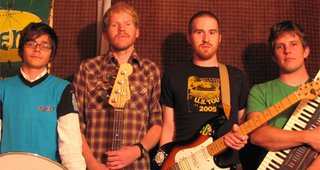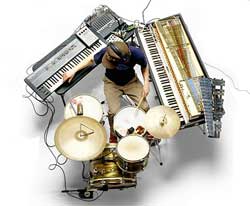
Rock Club Movie Night: Gimme Shelter (1970--Criterion Edition)
I first saw this movie sometime in the early 1980s on local station WDCA 20, on a 12-inch Sony color television. The times they are a-certainly becoming different. Now, in 2006, Rock Club watched the remixed-and-remastered-by-Criterion DVD of the documentary Gimme Shelter. Gimme Shelter tells the story of the Rolling Stones and their ill-fated answer to
Okay, I’ll throw it out there. This is one of the best movies I’ve seen in a while, and maybe one of the best I’ve ever seen. The presence of Dan and Erin made me check my gushing, but if I’m honest I have to say I was mesmerized by this movie. Much of the appeal, again, has to do with Criterion—if you plan on renting this, make sure you get the Criterion edition. Only Criterion will do. Got it?
The story of this movie, in my opinion, is something more elemental than “the Death of the 60s”, or something more big picture. In my mind, Gimme Shelter is a movie about what happens when 300,000 people converge upon a large open area with limited access roads, few toilets, and a very, very, very popular band playing at one end. The movie is almost like a Discovery Channel nature documentary. If you’ve ever been in a big crowd, and felt a surge, or a sway, or just some sweaty dude up on your back, when maybe for a second you thought, I really wish I weren’t in this crowd, and later I have fucking have to get some air, then you’ll feel that anxiety while you watch Gimme Shelter. It’s sickening to watch a crowd crush, either filmed, or live. I suppose for me it’s comparable to watching a movie with a shipwreck survivor bobbing in the water, knowing the sharks are underneath. A few things can happen in either situation, and all of them are bad.
That’s not to say there aren’t other stories in this film. First, the Rolling Stones, in 1969, were the most fantastic band on the planet. The Beatles had recorded all the music they would ever record, and Jagger and company were on top, but—and I say this as a committed Beatles fan—I don’t think it would ha ve mattered if the Beatles were still together, because, as the live performances in this movie prove, no band could rock like the Rolling Stones in 1969. The movie opens with footage of the band at
ve mattered if the Beatles were still together, because, as the live performances in this movie prove, no band could rock like the Rolling Stones in 1969. The movie opens with footage of the band at
The movie, contrary to how I remembered it from my 1980s viewing, isn’t about just
The Stones began their 1969 tour in support of their new album, Let It Bleed. They hadn’t been t o
o  um is wonderful and I recommend every human on earth buy a copy immediately—not in the movie, but also fantastic songs, are “Midnight Rambler” and “Monkey Man”, the latter the soundtrack to Ray Liotta’s coke-fueled downfall in Goodfellas. And once again, the Criteria remix is superlative—the surround sound makes it seem as if you’re front-row, off to the left, a little back. Which is my preferred spot.
um is wonderful and I recommend every human on earth buy a copy immediately—not in the movie, but also fantastic songs, are “Midnight Rambler” and “Monkey Man”, the latter the soundtrack to Ray Liotta’s coke-fueled downfall in Goodfellas. And once again, the Criteria remix is superlative—the surround sound makes it seem as if you’re front-row, off to the left, a little back. Which is my preferred spot.
But you realize early on in this movie, the story is the crowd. The camera catches the audience, streaming onto the speedway grounds like ants. The close-in shots are fascinating—the color of the movie, the clothes people are wearing, the haircuts. It’s endlessly fascinating. I’ve now watched it twice since I’ve rented it and will likely give it a third viewing sometime in the near future.
If you don’t know the story of Altamont, the Hell’s Angels, Oakland Chapter, were hired to do security at the festival, which was the West Coast answer to  e security at many Grateful Dead shows, and thus had experience in crowd control with a hippie audience. But the brute size of the crowd—and the movie includes aerial scenes of it, shot from a helicopter—is overwhelming.
e security at many Grateful Dead shows, and thus had experience in crowd control with a hippie audience. But the brute size of the crowd—and the movie includes aerial scenes of it, shot from a helicopter—is overwhelming.
From the start of the festival, the vibe is bad. Fights break out during the Flying Burrito Brothers set, followed by more scraps during the Jefferson A irplane. Actually, “scraps” underdoes it, as Airplane guitarist Marty Balin is knocked unconscious by an Angel. By the time the Stones appear, the atmosphere is angry and ominous. Not helped by the one-foot high stage, the Stones do their best to quell the violence, but the crowd by this point is a multi-cell organism, with a terrible imperative to get closer and closer to the stage. The movie shows countless fucking weirdos rushing the stage, pressing forward, undergoing really really bad acid trips and assuming talking to Mick will help them. From the start it was bad—a scene showing the Stones’ helicopter-borne arrival at
irplane. Actually, “scraps” underdoes it, as Airplane guitarist Marty Balin is knocked unconscious by an Angel. By the time the Stones appear, the atmosphere is angry and ominous. Not helped by the one-foot high stage, the Stones do their best to quell the violence, but the crowd by this point is a multi-cell organism, with a terrible imperative to get closer and closer to the stage. The movie shows countless fucking weirdos rushing the stage, pressing forward, undergoing really really bad acid trips and assuming talking to Mick will help them. From the start it was bad—a scene showing the Stones’ helicopter-borne arrival at
The Mansonite side of 1960s  ing his back and crossing himself is distressing). Hunter is glimpsed earlier in the movie, during a crowd shot—his lime green tuxedo jacket; his sweaty, twitchy amphetamine face, and big afro, stick in the mind. The stabbing unfolds with a predictability that is sickening. My hypothesis is that Hunter was pressed into the security line of Angels, took exception to their rough treatment, got his ass beat, came back with a gun, and that was that. See the Rolling Stones and get killed, I guess.
ing his back and crossing himself is distressing). Hunter is glimpsed earlier in the movie, during a crowd shot—his lime green tuxedo jacket; his sweaty, twitchy amphetamine face, and big afro, stick in the mind. The stabbing unfolds with a predictability that is sickening. My hypothesis is that Hunter was pressed into the security line of Angels, took exception to their rough treatment, got his ass beat, came back with a gun, and that was that. See the Rolling Stones and get killed, I guess.
The killing is horrifying and the Stones absolutely rock out from this point on. It sounds callous, but to have called off the show at that point would certainly have provoked further violence, so they keep going—the crowd certainly backed off after the stabbing, allowing the show to take place. It’s a sick compromise, but it’s one more reason this film is great. The band plays more out of fear, than anything else, and they sound absolutely terrific.








